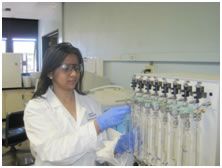Co-entrapment of Iron Nanoparticles and Trichloroethylene (TCE) Degrading Bacteria in Alginate Biopolymer for Groundwater Remediation

Sharanya Shanbhogue is a Master of Science student in Environmental Engineering program at North Dakota State University. She holds a Bachelor of Technology degree in Chemical Engineering from Anna University, Chennai, India. Her present research focus is on the co-entrapment of nanoscale zero-valent iron particles (NZVI) and bacteria in alginate capsules for groundwater remediation applications.
Email: sai.shanbhogue@ndsu.edu
Phone: 701-231-7051
Fellow: Sharanya Shanbhogue
Advisor: Achintya Bezbaruah, Ph.D., Assistant Professor, Department of Civil Engineering, North Dakota State University.
Co-Advisor: Dr. Eakalak Khan, Ph.D., P.E., Professor and Dept. Chair, Department of Civil Engineering, North Dakota State University.
Degree Progress: M.S. in Environmental Engineering expected graduation in fall 2011.
Co-entrapment of Iron Nanoparticles and Trichloroethylene (TCE) Degrading Bacteria in Alginate Biopolymer for Groundwater Remediation
This research focuses on the encapsulation of iron nanoparticles and microorganisms into alginate capsules (reactors). The combined microorganism-metal system can be used for the remediation of environmental contaminants present in groundwater. This system is a good choice because it is a cost effective, environmentally friendly, and can be used to remediate a wide range of contaminants. The interactions between iron nanoparticles and microorganisms have been explored by prior work in our research group. NZVI have been used to remediate a wide range of groundwater contaminants including chlorinated compounds (e.g. TCE). Their small size and high reactive surface area make them highly efficient for contaminated water remediation. However, NZVI particles exhibit high Brownian motion and collide against each other and agglomerate. Agglomeration causes them to sediment out in the aquifer pores and they become unavailable for contaminant remediation. Effective delivery of the NZVI particles is essential to ensure the success of the in-situ remediation process. NZVI can be effectively encapsulated/entrapped in alginate polymer without any significant reduction in their reactivity. The entrapment process reduces the mobility of the NZVI particles and, thus, helps curb the sedimentation problem. The porous nature of Ca-alginate allows solutes to diffuse and come into contact with the entrapped NZVI. Alginate is a very extensively used as surface modifier for NZVI. Furthermore bacterial cells encapsulated within calcium alginate have been used extensively for environmental remediation.
Project Objectives:
The main objective of this study is the co-entrapment of NZVI and TCE degrading bacteria in alginate polymer to achieve complete degradation of TCE in groundwater.The Specific Objectives of this research are:
- Encapsulation of NZVI and microorganism in alginate polymer.
- Conduct degradation experiments for TCE
- Monitor TCE degradation using different species of TCE degrading bacteria (e.g., Pseudomonas putida F1, Dehalococcoides sp.) in the capsule.
Progress:
Alginate capsules have been synthesized and NZVI was successfully encapsulated. Diffusion and treatability studies using encapsulated NZVI was performed for varying concentrations of TCE. Microorganisms were encapsulated and used for TCE degradation. Encapsulated NZVI, microorganisms, and the combined metal-microorganism system were found to be effective for TCE degradation. The project is on-going using different strains of microbes to test the efficacy of the combined metal-microorganism system. Based on the progress made so far a manuscript has been submitted to a peer reviewed journal.
Significance:
The proposed technique will be applicable for both surface and groundwater TCE remediation. Environmental nanotechnology is one of the fastest emerging areas in the field of remediation and the results of this study will be of publishable in a peer reviewed journals. This project explores the most recent technology and brings out a unique 2-stage method for remediation of water. Once tested the NZVI-microorganism system can be used for in-situ groundwater remediation (in permeable reactive barriers). The research results will benefit North Dakota as there are a number of TCE contaminated sites in the state.
Research Outcomes:
Sharanya Shanbhogue, Achintya Bezbaruah, Eakalak Khan, Senay Simsek .Co-entrapment of Iron Nanoparticles and Trichloroethylene Degrading Bacteria for Groundwater Clean-up. World Environmental and Water Resources Congress, Palm Springs, CA, May 2011
Sharanya Shanbhogue, Achintya Bezbaruah, Eakalak Khan, Senay Simsek. Encapsulation of Iron Nanoparticles in Alginate Capsules for Groundwater Trichloethylene Remediation. Eastern South Dakota Water Conference, Brookings, SD, November 2010. Award Winning Poster.
Sharanya Shanbhogue, Achintya Bezbaruah, Eakalak Khan, Senay Simsek. Encapsulation of Nanoscale Zero-valent Iron (NZVI) particles and Microorganisms in Alginate Biopolymer for Groundwater Trichloroethylene Remediation, EPSCoR State Conference 2010, Grand Forks, ND, October 2010.
Sharanya Shanbhogue, Achintya Bezbaruah. Encapsulation of Zero-valent Iron Nanoparticles (NZVI) in Alginate polymer for Groundwater Remediation. AWWA Surface Water Treatment Conference, Fargo, ND, April 2010.

Achintya Bezbaruah
Civil & Environmental Eng.
Office: Civil/Ind Eng 201G
Telephone: 701-231-7461
Email: a.bezbaruah@ndsu.edu

Eakalak Khan
Civil & Environmental Engineering
NDSU


